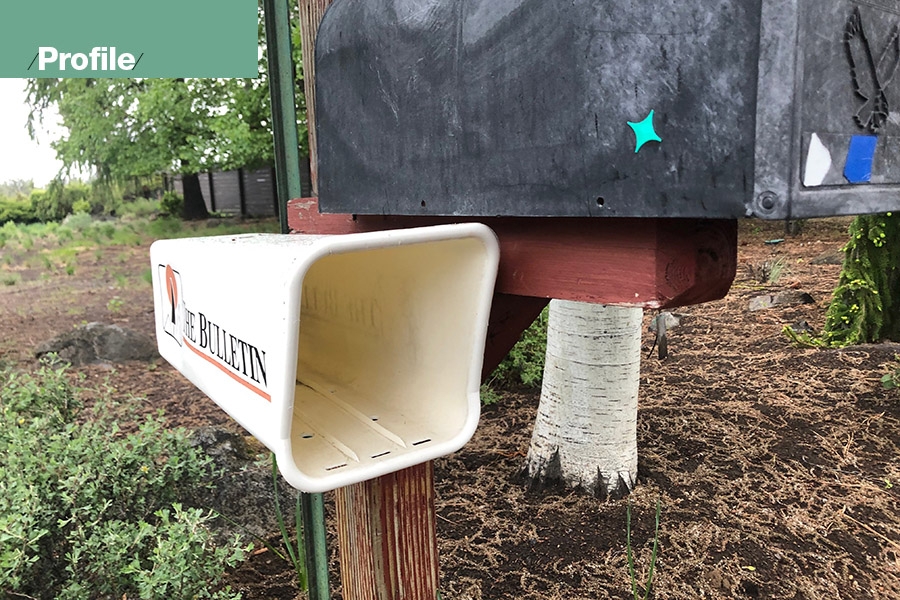The Bend Bulletin newspaper may have gone through bankruptcy, but businesses still want to advertise.
Stroll through Bend’s neighborhoods of updated Craftsman, older construction and more contemporary homes, and many residents who’ve updated their mailboxes (say, to stronger metals or to those that lock) still have attached plastic newspaper holders labeled The Bulletin.
The visual expectation is that these residents still subscribe to and receive Central Oregon’s largest daily newspaper. And while many still take the paper — it has a weekday circulation of 27,000 — it’s evident the newspaper boxes today sit more idle than they had in the recent past.
And storefronts, cafes and the like, which seem expected places to find The Bulletin, often have instead free circulars and other less news-led publications.
These clues represent the newspaper’s troubles: poor business decisions, overspending on real estate and an uncertain future for print media.
And yet, for the local businesses that place ads in its daily, which was established in 1903 and known since 1963 as The Bulletin, the bankrupt newspaper remains a stalwart, an important avenue to get the word out about their products and services.
Business owners report their customer base in Deschutes, Jefferson and Crook counties is a print-reading crowd, and they pay attention to the ads alongside local news and features coverage.
THE BULLETIN is at a crossroads as Oregon newspaper publisher EO Media Group successfully bid in July to buy the newspaper and its sister publication, the weekly Redmond Spokesman, from parent company Western Communications.
Bend-based Western Communications filed for Chapter 11 bankruptcy protection for the second time on Jan. 22. The Bulletin’s staff shrank internally as dozens of reporters lost their jobs or left voluntarily.
The court filing reports the company owns seven “markets” (newspapers) across rural Oregon and Northern California. The Bulletin is the flagship title in a media landscape otherwise bereft of local coverage.
Western Communications’ assets are noted at up to $30 million.
Newspapers alone do not make up its assets; real estate holdings are among the most lucrative, according to the debtor’s disclosure statement dated May 22.
Western Communications underwent a restructuring and secured a new building near downtown Bend as its headquarters and printing plant.
But a lack of liquidity forced the company to put the building on the market in 2017. It remains for sale for roughly $19 million. The bankrupt publisher anticipates completing the sales of its commercial properties by October 2019, according to a court filing.
Ken Doctor, media analyst with Newsonomics, based in Santa Cruz, Calif., says Western Communications “torpedoed” itself with shoddy financial decisions.
The “self-inflicted wound” of its overspending on the now-empty office building in Bend and tax issues weakened the company in an adverse financial climate for newspapers.
But despite the problems at the newspaper, businesses in the region still want to advertise. Not one of the business owners interviewed for this story say they wouldn’t place an ad under the new owner.
Les Zaitz, a rancher, former journalist at The Oregonian and owner of the Malheur Enterprise and Salem Reporter, is a fierce advocate of local news. He doesn’t work on the ad side of the operation — nor is he affiliated with Bend’s paper — but is keenly aware of newspapers’ key relationship to the business community.
RELATED STORY: Oregon’s Honorable Titan
Placing ads in newspapers, Zaitz says from his ranch two hours south of Pendleton, “is not necessarily for the newspapers but for local businesses.” He posits that local businesses’ success helps newspapers themselves succeed.
“It’s important in any local community for its newspapers to have a certain relationship with their businesses to use to their benefit,” Zaitz says.
“The digital world is so utterly fragmented that print gives people a place to know what furniture is on sale this weekend and what band is playing at the local brewpub.”
Zaitz acknowledges that he “did toy with the idea” of acquiring The Bulletin, “but I’m a news guy and not a business guy, and rounding up $3 million to buy the paper was not on my summer to-do list. I don’t have that many Green Stamps,” he quips.
The Bulletin’s value is estimated at about $2.5 million.
Zaitz cautions: “New owners of any newspaper, particularly corporations, will have a far better chance of succeeding if they don’t import their ideas alone but instead plug into the community to learn its history, people and issues.
Simply putting out a newspaper or putting stories online won’t do. When readers trust that news sources are serving the community, they respond with support.”
NATIONWIDE NEWS DELIVERED in print is on the decline. In the past six years, more than 100 newspapers have turned off their presses, says Doctor. Around the country, print advertising is down by up to 15% for the third year in a row.
Google and Facebook, for example, now represent up to 70% of local digital advertisements.
A saving grace for print is that the average consumer of news in that format skews older, says Doctor, which is exactly Central Oregon’s subscribing demographic.
Also going for The Bulletin is its size; smaller papers tend to have “a larger margin of error,” says Doctor, meaning their staying power for now outpaces that of larger newspapers.
Central Oregon business owners indeed feel supported by their largest daily newspaper, regardless of the anticipated changes at the top.
Bill Fellows recently bought Cynthia’s of Bend from his parents, the sewing store’s original founders and owners. The only business owner interviewed for this article to disclose ad-budget information, Fellows says he spends $120 a month to place small ads in The Bulletin’s front section.
He admits to not reading the paper himself. But his demographic does. “People come in and say, ‘I saw your little ad in The Bulletin,’” he says.
Fellows, who’s lived in Bend for 10 years, echoes another common refrain: “It doesn’t make any difference to me who owns the publication,” he says. “I just want Bend residents to come in to my store and do business, you know?”
Michelle Mathieu manages Sisters-based store The Jewel, owned and operated for 28 years by Jan Daggett, who designs its one-of-a-kind gold jewelry. The specialty shop also sells alabaster bowls and lamps, custom sinks, minerals and fossils.
The Bulletin, Mathieu says, “has been a great advertising avenue for us for two decades.”
Mathieu and Daggett agree that so far, dollar for dollar, print advertising produces far more customers than digital. Two years ago they placed ads on Google, but it wasn’t a successful venture. Rather, locals call and regularly walk in carrying ads from The Bulletin.
“Though we’d love to find a way to reach people out of the area, Central Oregonians have a lot of faith in keeping business local. All of these years and all of this technology, and we still get more foot traffic through print,” says Mathieu.
Robert Vann, Stark’s Vacuums’ Bend-based branch manager, says he has regularly bought ads in The Bulletin since he opened his store 11 years ago, one block from Costco. He says The Bulletin is the recipient of 75% of his advertising budget and runs his ads three days a week.
“I like to hold something in my hand and read it,” says Vann, 56. His customer demographic — into which Vann himself falls — is selective about what publications they choose.
“I mean, there’s The Source Weekly,” he says, likening it to the Portland area’s kind-of-hip Willamette Week — “but I don’t know how many 50- to 70-year-olds are sitting down to read the pot columns.”
“The digital world is so utterly fragmented that print gives people a place to know what furniture is on sale this weekend and what band is playing at the local brewpub.”
Les Zaitz, owner of Salem Reporter and Malheur Enterprise
The Jewel, Stark’s and other Bulletin advertisers indeed benefit from their customers’ demographic and their tried-and-true love and greater trust of media they can touch and page through.
“There is still a place for print ads,” Vann says.
To the casual observer, Bend and its hot housing market attract young families and the outdoor activities to match their energy and interests.
What may be less obvious is the city’s aging population and their counterparts moving in from elsewhere to buy a home and retire smack in the middle of the state.
Roughly 20% of the overall population of about 214,000 residents in Deschutes, Jefferson and Crook counties is 65 years of age and older, according to U.S. Census Bureau data.
“Our demographic definitely skews older,” says Belinda Chavez, director of marketing for Warm Springs Casino Enterprises, owner of the 500-seat Indian Head Casino in Warm Springs, Central Oregon.
“Many of them are still readers, not like millennials. That’s why we still have a significant investment in print, because they still sit down and look at that paper,” she says of The Bulletin, which runs her ads every Friday.
Chavez directs advertising dollars to other local print publications, such as those in Redmond and Prineville, as well as for TV and radio spots.
But her budget remains weighted toward print. “It has always been a channel we have utilized. You can read all the rankings you want, but in rural Oregon, print is key,” she says.
Print may not be prime forever. Vann, the branch manager of Bend-based Stark’s Vacuums, says “the $64,000 question” is where the majority of ad dollars should go for “brick-and-mortar retailers” like his.
“You only have so much money to spend, and now we’re on the digital bandwagon,” he says of dabbling in digital advertising.
But he adds: “For the foreseeable future, I’ll stay in The Bulletin three days a week.”






